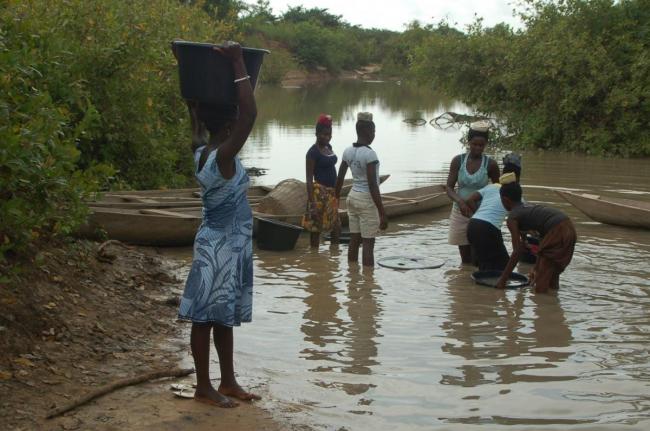Does using a household water filter help in improving water quality and reduce incidence of diarrhoea?
Published on: 28/05/2018
This guest blog is written by Freda Adiali (Wageningen University) and Eline Boelee (Deltares, Water Health)

Still 2.1 billion people in the world are without access to safe water at home. An even larger number of people, 4.5 billion, do not have access to safely managed sanitation. This is why thousands of children die every year. This burden of diarrhoea is measured in disability-adjusted life-years (DALYs), a composite metric of mortality and morbidity, and amounts to a quarter of the global DALYs.
Contemporary systematic reviews and meta-analyses of domestic water quality interventions indicate that, though these interventions are generally effective in preventing diarrhoea, still thousands of Ghanaian children die from diarrhoea each year.
In 2014, IRC jointly with World Vision International, Water Health, and the University for Development Studies, Tamale, conducted a pilot study on the ProCleanse water filtration system. It was an effort to assess the extent to which a household water treatment system (HWTS) improved drinking water quality in eleven selected communities in Savelugu-Nanton Municipality (see the box below). Although the study was not designed to quantify health impacts, some additional data analysis was done to try and find out what we can learn about the various influences on people's health. The findings were not what we expected!
Testing ProCleanse HWTS – a randomized trial-control | ||||||
Design of the study
| | |||||
Results
| ||||||
|
|
|
|
|
| |
| Round | Safe | Low risk | Max |
| |
| 1 | 90% | 6% | 105 cfu/100ml |
| |
| 2 | 81% | 15% | 58 MPN/100ml |
| |
| 3 | 80% | 14% | 45 MPN/100ml |
| |
Savelugu-Nanton Municipality
Savelugu-Nanton Municipality is one of the 216 Metropolitan Municipal District Assemblies (MMDAs) located in Northern Ghana. More than half of the population depend on dugouts, dams, ponds, open wells, lakes and streams for drinking water, which are often contaminated with faecal matter. The scarcity and irregularity of water supply, and the distance to water sources lead to the inevitable practice of households storing water for future use. More often than not, this water is stored in big containers made of earthenware, plastic, or concrete. This influences water quality since not all the water is used up on the same day. Although one-third of the population have access to safe drinking water, little is known about the quality of water at the point of consumption, and how this is influenced by hygiene practices.

Water source, use, hygiene behaviour and health
This study showed that the main water sources in these communities are natural sources and boreholes, and the water is used for drinking, cooking, or handwashing. More than half of the households collect their water from natural surface water sources and one-third obtain their water from boreholes. Generally, regardless of water use, people select their water source based on availability, distance, burden of fetching, and time spent at the borehole.
The source of water relates to the occurrence of diarrhoea among children, with a greater number of cases found in households without safe drinking water. Diarrhoea cases were also related to hygiene practices. This means that among people with improved water sources and good hygiene behaviour less children had diarrhoea.
Most people in these communities practice open defecation, which results in poor environmental health. There is a weak association between educational level of respondents, type of toilet facilities, and household assets.
Health Impact of HWTS
After the third month of the five-month period of the usage of filters, there seemed to be no clear link between the use of the filters and childhood diarrhoea in the households (as was expected from the study design). The occurrence of childhood diarrhoea in the households using filters hardly changed over the five months following the distribution of the ProCleanse HWTS. In some villages, more diarrhoea was recorded than in others. Interestingly, even among the households using the HWTS, there was more diarrhoea in the communities that depend on surface water. A possible explanation for this could be that households with filters do not treat all their water in the HWTS and still consume water from other sources, and not solely from the water filter. Other transmission routes such as contamination of cups, utensils and hands, related to hygiene behaviour also play a crucial role in the outbreak of childhood diarrhoea. In addition, economic factors influence health. Wealthier households and those with good hygiene practices show lower cases of diarrhoea.
Conclusions and Recommendations
While the HWTS did improve the quality of the drinking water (see box above), the study could not demonstrate a clear impact of the HWTS on the health of the people. The analysis showed that even among households using the filter, there were more cases of diarrhoea when the water was collected from an open source. In addition, hygiene behaviour and economic factors played a role. Further detailed statistical analysis could reveal more on the performance of the filters for improving water quality.
At IRC we have strong opinions and we value honest and frank discussion, so you won't be surprised to hear that not all the opinions on this site represent our official policy.